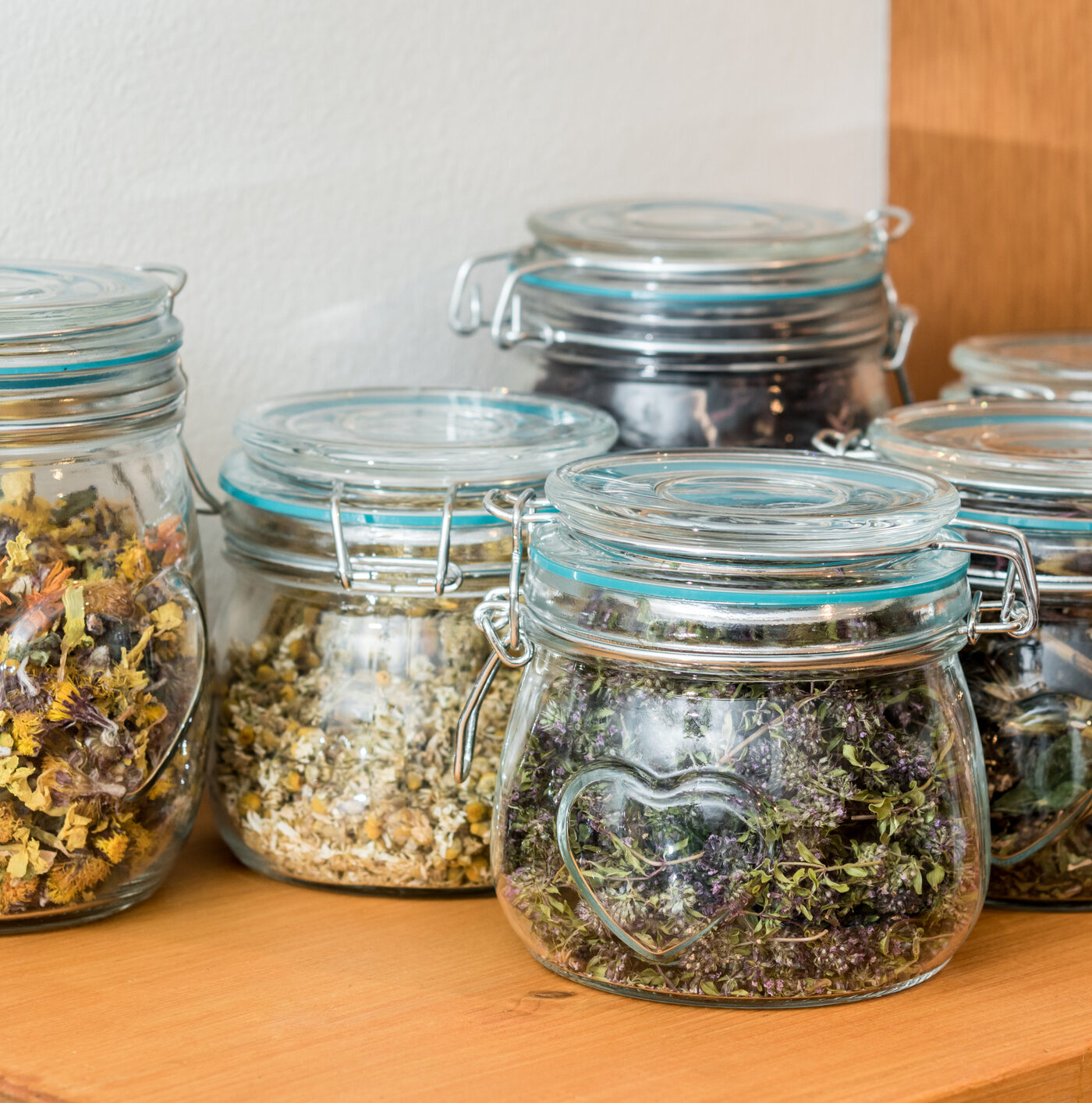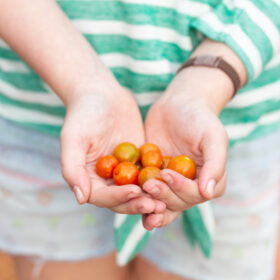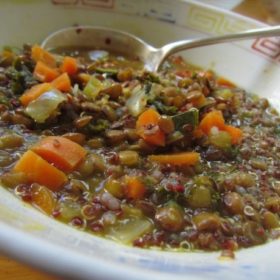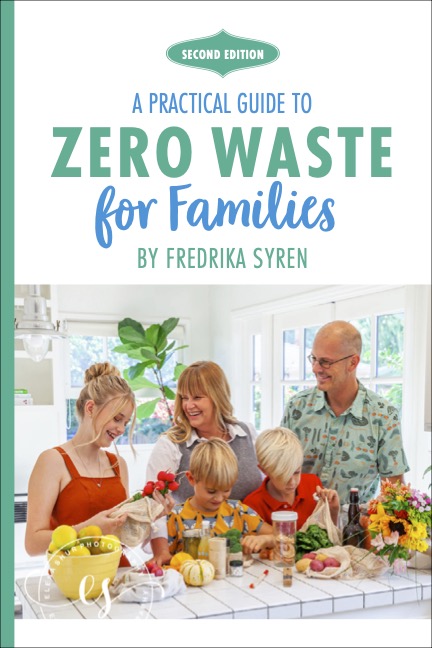Foraging for Natures Herbal Tea
Our family forages for all kinds of goodies during summer and early fall. You can read more about what we forage for here and check out YouTube videos of us foraging blueberries, chokeberries, and rosehips.
As huge tea drinkers, we love forging and preserving herbal teas. We grow herbs in our garden for herbal tea, but you can get free herbal tea from nature if you don’t have a garden.

When foraging wild herbs, it is crucial to positively ID the plants you’re picking. If you’re new to foraging, I recommend going with someone who knows wild herbs and can teach you to identify them. You can also buy an edible wild plant book to bring with you. You also want to make sure only to harvest wild edibles in safe areas, far away from busy roads, construction sites, and areas sprayed with pesticides.
Be respectful and never pick more than nature can handle. Only pull up plants by the roots if you need the roots, and do not trespass on other people’s farms to pick herbs. Never pick endangered species.
As with any herb, it’s important to start drinking wild teas in small amounts to see how you respond. If you have a medical condition, are pregnant, nursing, or on medication, be sure to check with your health practitioner before drinking any herbal teas.
When picking wild herbs, bring:
· Baskets and bags — Helpful for storage and so you can package different herbs separately
· Scissors
· Gloves — Since some herbs like nettle, rosehips, and raspberry leaves can have thorns or spikes, gloves will protect your hands

Here are our favorite wild herbs for herbal tea:
Chokeberries — Aronia berries are dark blue berries that grow on a bush, usually in cities. The berries are drank as tea and have many health benefits.
Raspberry leaves — After the raspberry bush has produced berries, we forage the leaves to make a delicious tea. I began drinking raspberry leaf tea when I was pregnant. As a matter of fact, I’m sitting here with a cup of foraged raspberry leaf tea as I’m writing this.
Raspberry leaves contain vitamins, micro and macro elements, tannins, pectin, organic acids, and essential oils. They’re filled with powerful antioxidants that strengthen the immune system, neutralize dangerous free radicals, and improve the condition of the nervous system.
Chamomile — My kids drink chamomile tea pretty much any time they are sick. They enjoy it before bed because it helps relax them and ease anxiety. Chamomile is anti-inflammatory, helps alleviate PMS symptoms, soothes stomachaches, and promotes healthy skin.
Nettle — I have written a lot about these little weeds because nettle is, in my opinion, a superfood. You can read more about the many uses of nettle here. Nettles contain restorative elements that boost the immune system. They are rich in vitamins A, C, K, calcium, potassium, and iron. I drank nettle tea during my pregnancy and after giving birth to boost my iron levels.

Rosehips — A rosehip is the fruit of the rose bush that grows after the rose bush is done blooming and the flower petals have fallen off. Rosehips are orange or red-colored fruits, and you can harvest them in the fall. Rosehips are naturally high in vitamin C, so they’re great to have around during cold and flu seasons. I always dry rose hips for tea, which tastes delicious, prepared hot or cold. To prepare, use a tablespoon of dried rosehips to about 2-3 dl of water. Bring to a boil in a pan and allow it to steep for a few minutes. Strain and sweeten if you like!
Elder — Beautiful, white elderflowers can be harvested in early summer. Elderflowers contain lots of antioxidants and boost the immune system. They also help with swollen sinuses, colds, flu symptoms, bronchitis, and constipation. We also harvest elderberries in the fall to make syrup. Raw elderberries are poisonous and must be cooked before consumption.
Blueberry — I like making blueberry tea with dried blueberries and blueberry leaves. This delicious anti-inflammatory tea contains lots of antioxidants and has anti-allergen properties.
Dandelion — It’s so funny that dandelion flowers are the worst enemy of anyone on a quest for the perfect grassy yard, but they’re a source of major fun for a child. I remember loving dandelions as a child. Their leaves were food for my rabbit, and their yellow flowers made beautiful crowns for my fellow princesses and me. The wishing flowers were delightful entertainment, their seeds spreading while I blew on them and made wishes.
Most people don’t know that dandelion has a long history of traditional medicinal uses. Dandelions grow nearly everywhere! They’re rich in potassium and are known for cleansing the body and keeping fluid levels balanced, which benefits many organs and body functions. Every part of the dandelion plant is edible, including the roots, stem, leaves, and flowers.

To preserve herbs for tea, you can dry them by air drying, sun drying, dehydrating, or oven drying.
Air Drying
Air drying herbs is super easy; you can dry whole sprigs or leaves. Put on a net or hang on a stick/wire and wait a few days.
Sun Drying
Sun drying is done outdoors. You can place cleaned herbs in the sun, directly on screens or drying trays, in an area protected from insects and moisture. Make sure to bring trays indoors at night in case there is any dew. You should protect the drying trays from insects by covering the tray with Remay or cotton netting.
The ideal temperature for sun drying is between 85 – 100 degrees. Be sure to rotate the shelves so the herbs dry evenly.
Electric Dehydrators
This is my favorite way of drying any harvest. I use an Excalibur dehydrator with five trays, but there is also a larger one with nine trays if you need to dehydrate a large harvest.
These dehydrators come with built-in fans, which speed up the drying process. Mine is equipped with timers, which help make multiple batches more consistent. I dry my herbs in the dehydrator at 100°F in a single layer until completely dry.
Oven Drying
You can also use the oven for drying, especially for small amounts of herbs. It can be challenging to maintain an even, low temperature in an oven (a maximum of 150 degrees) so the herbs won’t burn. Place herbs on a tray on the top shelf along with an oven thermometer, and keep the door open to monitor the temperature. Rotate the racks for even drying.

How to store dried herbal teas:
Store your dried herbal teas in an air-tight glass container. Keep your jar out of direct heat and light; the herbs should keep well into the following year’s harvest season.
Watch our YouTube Video of when we foraged chamomile









